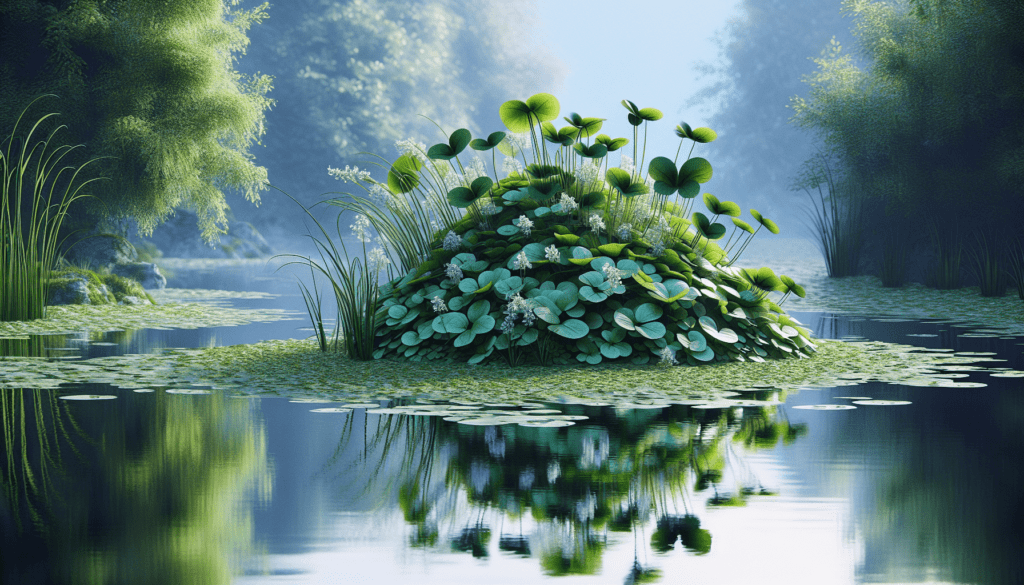In your exploration of aquatic botanical worlds, you might stumble upon a gem commonly known as Apium nodiflorum. This article seeks to elucidate the intriguing aspects of this aquatic plant, which despite its seemingly commonplace character, harbors an array of fascinating attributes. As you skim through the subsequent sections, your understanding of Apium nodiflorum, its genetic lineage, its peculiar biochemistry, and how these features impact its niche within aquatic ecosystems will gradually unfold in a coherent and site-specific manner. This intriguing voyage into the realm of Apium nodiflorum, much like the plant itself, lies beneath the surface, poised to offer an intellectual enrichment to those eager to immerse themselves in the depths of botanical knowledge.
Overview of Apium Nodiflorum
Definition and Other Names
Apium nodiflorum is a semi-aquatic plant species part of the Apiaceae family, which is popularly known as the carrot, celery or parsley family. Not restricted to a single common name, the species is interchangeably referred to as celery-leaved buttercup, fool’s watercress, and water celery in the vernacular.
Origins and Distribution
The geographical origination of Apium nodiflorum is placed within the Mediterranean region. Nevertheless, its relatively robust nature and invasive potential have seen it spread across the planet. It can be observed growing in the wild across Europe, Asia, North America, and even Oceania.
General Appearance
The Apium nodiflorum plant embodies a typical herbaceous Physicality, with trailing, hollow, and smooth stems. The foliage is detectably similar to that of celery hence the common name ‘celery-leaved buttercup’. It possesses rather small, white flowers clustered together and minute, globular-shaped fruits.
Description of Apium Nodiflorum
Physical Characteristics
Apium nodiflorum manifests delicate white flowers, distinguished by five petals and a cluster of stamens at the center. Its leaves, patterned akin to celery, are pinnate and often characterized by a vibrant green hue. The plant’s stem is hollow and cylindrical, with a smooth texture that’s cool to touch.
Growth Pattern
Apium nodiflorum is a perennial that shoots upwards during the spring and summer months, reaching an average height of 60 to 100 centimeters. Beyond its vegetative merits, the plant continues to exhibit invasive characteristics, rapidly filling its surroundings and extending beyond its initial confines.
Blooming Behaviors
The blooming period for Apium nodiflorum stretches out between June to September. During this time, it produces a profusion of tiny white flowers that cluster in umbrella shapes known as umbels – a distinct trait observed in the Apiaceae family. Following the flowering period, the plant generates an abundance of small, round fruit.

Ecological Role of Apium Nodiflorum
Habitat Preferences
Apium nodiflorum flourishes in marshy habitats, riverbanks, and ponds as well as in standing water bodies. As an adaptable species, it tolerates both partially shaded conditions and areas fully exposed to the sun. The plant prefers nutrient-rich, muddy, or loamy soil for its growth.
Interaction with Wildlife
The fool’s watercress is an invaluable food source for numerous invertebrates and herbivorous animals. It provides nectar and pollen for insects, including certain types of bees and beetles. The plant’s foliage and stems also form part of the diet for several waterfowl species.
Role in Ecosystems
Apium nodiflorum plays an important role in creating a habitat for freshwater invertebrates. Invasive in nature, it can often dominate waterways, supplying vital cover for fishes and other aquatic organisms. Moreover, it aids in controlling water body eutrophication by absorbing excess nutrients.
Human Uses of Apium Nodiflorum
Medicinal Uses
Historically, Apium nodiflorum has been used for its medical properties. Indigenous communities used the plant as a remedy for rheumatism, hemorrhoids, and kidney disorders. Current research is further exploring the plant’s potential cardiovascular benefits, anti-inflammatory, and antioxidant properties.
Culinary Uses
Contrary to its nickname, fool’s watercress isn’t typically employed in culinary activities. Although closely resembling celery leaves, this plant lacks in desired flavor. It is advised that the plant not be consumed due to its slight toxic attributes, especially when eaten in large quantities.
Use in Landscaping
Apium nodiflorum has been applied in the landscaping industry, specifically in aquatic and pond landscaping designs. It’s aesthetically pleasing and contrasts beautifully against more substantial water plants. Its ability to absorb excess nutrients also benefits water clarity, which is often a desirable trait for pond owners.

Environmental Conditions for Apium Nodiflorum Growth
Water Requirements
Water celery thrives in high moisture conditions, whether it’s planted in shallow water bodies or muddy, waterlogged soils. Dry, arid conditions often lead to its wilting and eventual demise.
Light Requirements
Apium nodiflorum is relatively tolerant when it comes to light exposure. It prospers in full sunlight as well as in partly shaded conditions. Such flexibility makes it potentially easy to grow in a variety of environments.
Soil Preferences
Apium nodiflorum has a particular proclivity for nutrient-rich, loamy, and muddy soils. It prefers a pH neutral to alkaline soil but exhibits high tolerance for various soil types, including clay, sandy, and gravelly soils.
Reproduction of Apium Nodiflorum
Flowering and Fruiting
Following its summer blooming period, the plant produces small, round fruits that split into two seeds. These seeds mature and, upon appropriate environmental conditions, break away to begin the germination process.
Seed Dispersal
Often, Apium nodiflorum reproduces through seed dispersal aided by water movement. The lightweight seeds can float, allowing currents to carry them downstream where they can then germinate in new locations.
Germination Process
The germination process of Apium nodiflorum seeds occurs once they have settled in a favorable environment, predominantly consisting of wet, nutrient-rich soils. Given the right conditions, seedlings sprout and the new plants begin their lifecycle.
Cultivation of Apium Nodiflorum
Propagation Techniques
This plant can be propagated through sowing seeds directly into the chosen habitat or by dividing existing plants. When sowing seeds, it’s crucial to ensure the soil remains permanently moist and situated in a sunny to partially shaded location.
Pest and Disease Management
Apium nodiflorum rarely suffers from serious disease or pest challenges. However, necessary precautions in observing and managing common problems such as aphids or fungal diseases should be integral to its cultivation.
Pruning and Maintenance
The invasive nature of Apium nodiflorum requires regular pruning to control its spread and maintain the desired appearance. During winter months, it’s advisable to trim any leftover foliage back to ground level to encourage rejuvenated growth in spring.
Apium Nodiflorum in Aquatic Environments
Apium Nodiflorum in Rivers and Streams
Rivers and streams create a conducive environment for Apium nodiflorum since they provide constant access to water. Their flowing nature aids in seed dispersal, allowing the plant to expand its reach effectively.
Apium Nodiflorum in Ponds and Lakes
Apium nodiflorum is a common presence in ponds and lakes, primarily along the margins. It creates dense mats of foliage which serve as habitat and breeding grounds for various aquatic insects and fish.
Apium Nodiflorum in Wetlands
Wetlands form another suitable home for Apium nodiflorum. The plant’s presence in such regions helps enrich biodiversity by forming an essential part of the food chain and providing cover for various animals.
Conservation Status of Apium Nodiflorum
Threats and Protection Measures
Apium nodiflorum is not classified under any significant conservation threat. However, its invasive potential often necessitates various forms of control to ensure it doesn’t overpower native plant species. Techniques include manual removal or the use of specific aquatic herbicides.
Status in Different Regions
In certain regions, Apium nodiflorum is deemed an introduced species, while in others it’s considered as native. However, it isn’t classified as an endangered or threatened species in any specific country or region, according to the International Union for the Conservation of Nature (IUCN).
Importance of Conservation
The conservation of Apium nodiflorum, as with any plant species, contributes to the preservation of biodiversity. It forms an important ecological component in water ecosystems, and the maintenance of its population aids in sustaining balanced and healthy freshwater habitats.
Interesting Facts about Apium Nodiflorum
Historical Usage
Historically, besides its medicinal usage, Apium nodiflorum has been incorporated into daily life through utilitarian means. For instance, owing to its strong-smelling foliage, it was used as an insect repellent.
Interesting Adaptations
Apium nodiflorum showcases fascinating adaptations to thrive in its preferred habitats. One such adaptation is its ability to produce a significant number of seeds –allowing it to colonize new areas swiftly through water dispersal.
Role in Folklore and Culture
Celery-leaved buttercup, despite not being a prime subject in folklore, finds occasional mentions in cultural traditions across different regions. For instance, it was once considered vital for warding off evil spirits and was often planted around dwellings for this purpose.
